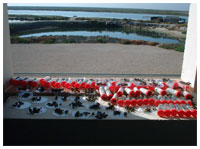home > research > local adaptation and population genetic structure in intertidal algae
Local adaptation and population genetic structure in intertidal algae
 The reproductive system shapes mating patterns thereby determining the organisation of genes in populations. Changes in the reproductive system can thus function as the drive for reproductive isolation and eventually for speciation. Population genetic studies can reveal the consequences of a particular reproductive strategy. In this theme we explore the relationship between reproductive strategies and population genetic structure in two closely related seaweed species, Fucus spiralis and F. vesiculosus, that have broad areas of sympatry along their distribution.
Hybridization between these two species has been suggested by reports of individuals with intermediate morphologies. Another goal was thus to use microsatellite data to gain accurate estimates of hybridisation frequency. Hybrid zones are excellent models for the study of evolution and maintenance of contrasting reproductive systems, as they are stabilized by the balance between introgressive gene flow and selection against hybrids contributing to maintenance of parental species integrity.
Since the cosexual/unisexual reproductive character has changed several times during the evolutionary history of the Fucaceae, the change from one reproductive system to the other may be relatively simple. We are continuing to investigate the reproductive system evolutionary steps along the evolutionary history of fucoid algae by means of mapping these onto molecular phylogenies.
The reproductive system shapes mating patterns thereby determining the organisation of genes in populations. Changes in the reproductive system can thus function as the drive for reproductive isolation and eventually for speciation. Population genetic studies can reveal the consequences of a particular reproductive strategy. In this theme we explore the relationship between reproductive strategies and population genetic structure in two closely related seaweed species, Fucus spiralis and F. vesiculosus, that have broad areas of sympatry along their distribution.
Hybridization between these two species has been suggested by reports of individuals with intermediate morphologies. Another goal was thus to use microsatellite data to gain accurate estimates of hybridisation frequency. Hybrid zones are excellent models for the study of evolution and maintenance of contrasting reproductive systems, as they are stabilized by the balance between introgressive gene flow and selection against hybrids contributing to maintenance of parental species integrity.
Since the cosexual/unisexual reproductive character has changed several times during the evolutionary history of the Fucaceae, the change from one reproductive system to the other may be relatively simple. We are continuing to investigate the reproductive system evolutionary steps along the evolutionary history of fucoid algae by means of mapping these onto molecular phylogenies.
 In the evolution from one reproductive strategy to another, while sexual differentiation is still incomplete one may expect to find populations of mixed sexual phenotypes, e.g. female or male and hermaphroditic morphs are observed. To understand the evolutionary mechanisms underlying the transition from one reproductive strategy to another, we are studying the sexual phenotypes of individuals in populations, and assessing the investment into male and female function of each sexual phenotype.
In the evolution from one reproductive strategy to another, while sexual differentiation is still incomplete one may expect to find populations of mixed sexual phenotypes, e.g. female or male and hermaphroditic morphs are observed. To understand the evolutionary mechanisms underlying the transition from one reproductive strategy to another, we are studying the sexual phenotypes of individuals in populations, and assessing the investment into male and female function of each sexual phenotype.On top, Cecile Perrin sampling Fucus vesiculosus in Morocco (photo by Filipe Alberto); left, inducing gamete release in Fucus at the Ria Formosa marine station (photo by Soraia Santos)
more photos


